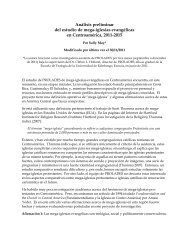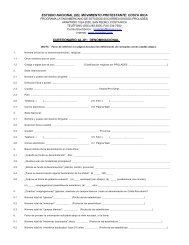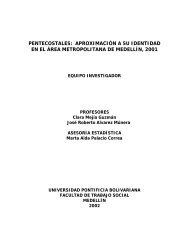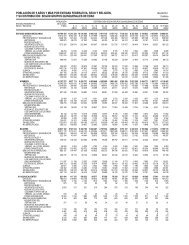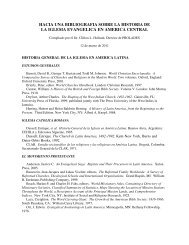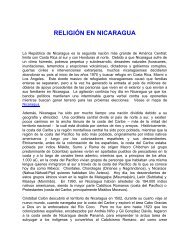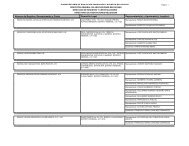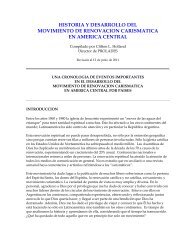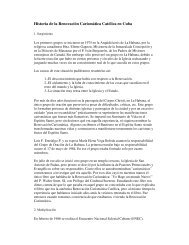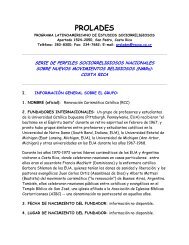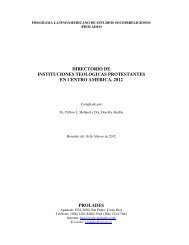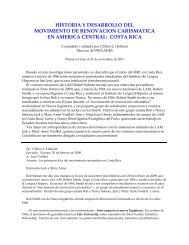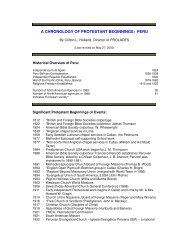belize, 1980 - Prolades.com
belize, 1980 - Prolades.com
belize, 1980 - Prolades.com
You also want an ePaper? Increase the reach of your titles
YUMPU automatically turns print PDFs into web optimized ePapers that Google loves.
William Wedlock and his wife arrived in Belize in March 1829 to take charge of the Methodist<br />
Mission, which by this time had not only suffered the loss of Wilkinson, but also of his replacement,<br />
Thomas Johnston, who arrived in 1827 and died six months later. Wedlock found only 10 freedmen<br />
attending the small Methodist chapel and proceeded to build up the congregation and the Sunday<br />
school. But it appears that his ministry was limited to the port city. When Wedlock left Belize for<br />
Jamaica in 1832 due to poor health, he left behind a congregation of 36 members, mostly free<br />
blacks and colored living in or near Belize City, although the Sunday attendance was considerably<br />
more, including 100 in Sunday school.<br />
Although there was some hostility against early Methodist missionaries in the Caribbean,<br />
those in British Honduras escaped from being vilified and blamed for promoting unrest among the<br />
Negroes during this period. Here missionaries were normally given permission to preach on arrival<br />
in the Colony. The only question that created some difficulty was over the performance of the<br />
marriage ceremony. One of the early Methodist missionaries, Thomas Johnston, argued that many<br />
slave owners had refused permission for their slaves to marry. At that time Dissenters were allowed<br />
to baptize slaves but not to marry them, and known marriages performed by Dissenters were<br />
declared illegal unless solemnized by the Church of England. Although no restrictions were placed<br />
on missionaries regarding their freedom to preach, it was customary for them to present their<br />
credentials on arrival, whereupon the Magistrates gave them permission to reside and preach in the<br />
Colony. However, the English Marriage Act was passed by Parliament in 1836, which allowed<br />
Dissenters to perform marriages, and the West Indies colonies were urged to do likewise. Although<br />
this was soon done in the Crown Colonies, no such act was passed in British Honduras until 1852.<br />
It was only in 1951 that the Public Meeting passed an act allowing the Wesleyan, Baptist and<br />
Presbyterian ministers to officiate at the funerals of their own church members, with such permission<br />
extended to the Catholics the following year.<br />
Meanwhile, the Rev. James Edney had succeeded the Wedlocks in 1832, and he carried<br />
the circuit through the crises of Emancipation in 1834 and into a fruitful period of expansion.<br />
Whereas the Methodists had little more than gained a foothold in Belize during the first nine years<br />
there, under Edney's leadership the circuit was enlarged to include out-stations at Mullin's River and<br />
Stann Creek, in addition to a few other preaching points along the river banks. As early as 1834, a<br />
Methodist chapel and school were serving the Black Carib population in the Stann Creek area where<br />
some 50 Black Caribs were regularly attending the Methodist school in 1838. But until 1840,<br />
Edney's only notable success was among the larger <strong>com</strong>munity in Belize City, where the Methodist<br />
congregation now included nearly 200 persons, among whom were many of the most respectable<br />
families in town. Edney quickly gained the respect and support of generous friends among the<br />
businessmen in Belize City, who aided the missionary in building a new chapel in town and in<br />
purchasing a boat that was used to visit settlements along the central and southern coast.<br />
Additional funds were also received from the Wesleyan Methodist Missionary Society for these<br />
projects. Beginning in 1845, when Edney made his first trip to Ruatán, a Methodist circuit was<br />
formed in the Bay Islands of Honduras that was supervised by the Methodist Mission in Belize.<br />
However, the arrival of thousands of Mayan refugees from Mexico to the northern lowlands<br />
of Belize, due to a race war between the Indians and Mestizos in the Yucatan Peninsula, awakened<br />
the Methodist Church to the need for missionary outreach among the Mayans. At this time, 1848,<br />
the Belize Circuit was served by two missionaries and counted 350 baptized members, mainly in<br />
Belize City where a Methodist Day School was established and was served by an English<br />
schoolmaster. The Rev. Joseph Webster supervised the Methodist Mission from 1847 to 1851, but<br />
he was only able to acquire a limited knowledge of Spanish; his ministry among the Mestizos and<br />
Spanish-speaking Mayas was, therefore, limited.<br />
Fortunately for the advancement of Methodism in British Honduras, the Rev. Richard<br />
Fletcher, formerly a missionary in West Africa, arrived in Belize in 1855 and became one of the little<br />
43



